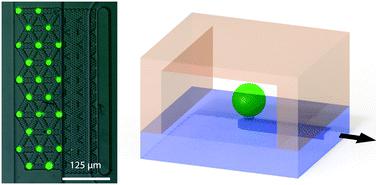Our official English website, www.x-mol.net, welcomes your feedback! (Note: you will need to create a separate account there.)
Planar hydrodynamic traps and buried channels for bead and cell trapping and releasing
Lab on a Chip ( IF 6.1 ) Pub Date : 2021-09-14 , DOI: 10.1039/d1lc00463h Clémentine Lipp 1 , Kevin Uning 1 , Jonathan Cottet 1 , Daniel Migliozzi 1 , Arnaud Bertsch 1 , Philippe Renaud 1
Lab on a Chip ( IF 6.1 ) Pub Date : 2021-09-14 , DOI: 10.1039/d1lc00463h Clémentine Lipp 1 , Kevin Uning 1 , Jonathan Cottet 1 , Daniel Migliozzi 1 , Arnaud Bertsch 1 , Philippe Renaud 1
Affiliation

|
We present a novel concept for the controlled trapping and releasing of beads and cells in a PDMS microfluidic channel without obstacles present around the particle or in the channel. The trapping principle relies on a two-level microfluidic configuration: a top main PDMS channel interconnected to a buried glass microchannel using round vias. As the fluidic resistances rule the way the liquid flows inside the channels, particles located in the streamlines passing inside the buried level are immobilized by the round via with a smaller diameter, leaving the object motionless in the upper PDMS channel. The particle is maintained by the difference of pressure established across its interface and acts as an infinite fluidic resistance, virtually cancelling the subsequent buried fluidic path. The pressure is controlled at the outlet of the buried path and three modes of operation of a trap are defined: idle, trapping and releasing. The pressure conditions for each mode are defined based on the hydraulic–electrical circuit equivalence. The trapping of polystyrene beads in a compact array of 522 parallel traps controlled by a single pressure was demonstrated with a trapping efficiency of 94%. Pressure conditions necessary to safely trap cells in holes of different diameters were determined and demonstrated in an array of 25 traps, establishing the design and operation rules for the use of planar hydrodynamic traps for biological assays.
中文翻译:

用于珠子和细胞捕获和释放的平面流体动力学陷阱和埋藏通道
我们提出了一种新概念,用于在 PDMS 微流体通道中控制捕获和释放珠子和细胞,而颗粒周围或通道中不存在障碍物。捕获原理依赖于两级微流体配置:顶部主 PDMS 通道使用圆形通孔与埋入的玻璃微通道互连。由于流体阻力支配着液体在通道内流动的方式,位于通过埋层内部的流线中的粒子被圆形通孔固定直径较小,使物体在上部 PDMS 通道中保持不动。粒子由其界面上建立的压力差维持,并充当无限的流体阻力,实际上取消了随后的埋藏流体路径。在埋藏路径的出口处控制压力,并定义了疏水阀的三种操作模式:闲置、截留和释放。每种模式的压力条件都是根据液压电路等效性定义的。聚苯乙烯珠在由单一压力控制的 522 个平行陷阱的紧凑阵列中被证明具有 94% 的捕集效率。在 25 个陷阱的阵列中确定并证明了在不同直径的孔中安全捕获细胞所需的压力条件,
更新日期:2021-09-14
中文翻译:

用于珠子和细胞捕获和释放的平面流体动力学陷阱和埋藏通道
我们提出了一种新概念,用于在 PDMS 微流体通道中控制捕获和释放珠子和细胞,而颗粒周围或通道中不存在障碍物。捕获原理依赖于两级微流体配置:顶部主 PDMS 通道使用圆形通孔与埋入的玻璃微通道互连。由于流体阻力支配着液体在通道内流动的方式,位于通过埋层内部的流线中的粒子被圆形通孔固定直径较小,使物体在上部 PDMS 通道中保持不动。粒子由其界面上建立的压力差维持,并充当无限的流体阻力,实际上取消了随后的埋藏流体路径。在埋藏路径的出口处控制压力,并定义了疏水阀的三种操作模式:闲置、截留和释放。每种模式的压力条件都是根据液压电路等效性定义的。聚苯乙烯珠在由单一压力控制的 522 个平行陷阱的紧凑阵列中被证明具有 94% 的捕集效率。在 25 个陷阱的阵列中确定并证明了在不同直径的孔中安全捕获细胞所需的压力条件,


























 京公网安备 11010802027423号
京公网安备 11010802027423号